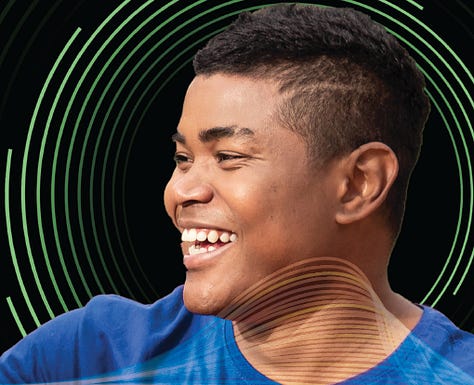Dichotomies: the other side of spatial computing
In our third issue, projecting the positive and negative possibilities of spatial computing helps us create the future we want.
Technology evolves faster and faster each year. It integrates further and further into society as well, leading to strong opinions from all corners on whether tech is a harbinger of destruction or of much-needed development. Each new step and change in tech advancement thus ratchets up the uncertainty we face, as anyone paying attention to the fervor around Generative AI can attest.
The latest example is the 2024 release of the revolutionary Apple Vision Pro1, which turned the phrase “spatial computing” into mainstream terminology. Spatial computing seamlessly blends the physical and digital, creating an immersive technology ecosystem for humans to interact with the world. This new paradigm senses real-world physical components, uses bridging technologies to connect physical and digital inputs, and overlays digital outputs onto a blended interface, like an advanced headset or smart glasses.
This new frontier of human-computer interaction could revolutionize the way we interact with the world. Instead of using wearable displays for virtual reality, we can choose to enrich our current reality by painting pixels over its canvas. The implications for business, personal communication, and public interaction are broad. So, how do we keep up with these new landscapes? By resorting to one of our oldest tools: storytelling.
I’m thrilled to announce the publication of Dichotomies: Spatial Computing, an innovative and hot-off-the-press work of speculative fiction. It’s the third issue in our Dichotomies series, which projects the possibilities of an emerging technology in two divergent scenarios and helps readers understand the implications and risks of the future. Our latest issue navigates the history of spatial computing from its infancy to the current moment, as well as its potential paths forward over the next decade. But what sets Dichotomies apart as a report is that is also plumbs the human experience, emphasizing the importance of empathy and proactive discussions in shaping our technological future.
The Dichotomies narratives feature six main characters across three domains: professional, personal, and public. These unique personas serve as our vehicle to examine both the positive and negative futures possible when spatial computing becomes ubiquitous. We visit Hiep among the snow-capped hills of Quebec to understand the future of remote work. We travel into the hustle of Tokyo with Temi. And we see Ally struggle to find community in her screen-addicted world. We hope that by visiting these characters and others, readers will consider the diverse perspectives and experiences that can shape our future interactions with emerging technologies. Crucially, each set of stories is also followed by actionable takeaways and industry-specific lessons that business leaders can consider for their own adoption of spatial computing.






At its core, Dichotomies illustrates the intricate dance between humans and machines. It challenges conventional workplace narratives and status-quos by sparking conversations through a combination of historical analysis, speculative fiction, and modern research and assessment. With the thought-provoking scenarios confronting these future personas, business leaders across industries are armed with a new tool: case studies from the future.
Fiction is a vehicle for business value.
As we continue to navigate the complexities of a rapidly changing world, storytelling will continue to serve as a compass, guiding us towards a future that is both innovative and humane. Through Dichotomies, we embark on a journey of discovery, where analysis, imagination, and empathy illuminate the right path forward in the age of spatial computing. Join us as we set out on this thrilling adventure. Because the future will not be entirely positive, or entirely negative. It will be as we make it, one story at a time.
Angela Huang | Dichotomies Author and OCTO Futurist
Dichotomies is an independent publication and has not been authorized, sponsored, or otherwise approved by Apple Inc.







